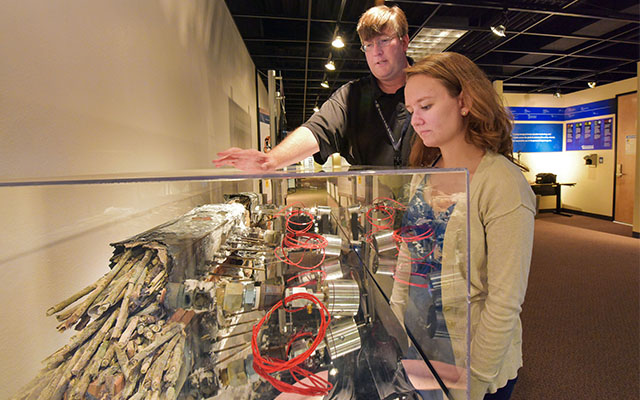Sandia helps spread lessons learned from Japanese reactor accident
When you’re an operator or engineer at a nuclear power plant, there are things you want to know long before you’re faced with an emergency.
The Technical Support Guidelines (TSG) Skillset Workshops, developed by the General Electric Boiling Water Reactor (BWR) Owner’s Group, bring together experts from Sandia and other places who share with engineers/operators the lessons learned in the wake of the Fukushima Daiichi nuclear accident and other severe accidents at nuclear power plants that pushed the facilities past their conceivable limits.
The workshops seek to demystify what actually happens during an accident, to help engineers/operators learn what types of decisions might need to be made in the event of an accident at their plant, and to provide insights into the non-intuitive nature of accidents. To date, workshops have been held in Taiwan, Japan, and the US, with additional workshops planned for Switzerland, Mexico, Spain, and the US.

Nuclear engineer Douglas Osborn (6232) shows student intern Anastasia Fox (6234) the results of an experiment that resulted in the zirconium cladding of a fuel cell catching fire. Douglas is one of the Sandia engineers sharing the lessons learned from mining Fukushima data with nuclear plant operators, to give them the knowledge they’ll need in the unlikely event of an accident. (Photo by Randy Montoya)
What to expect next
“By walking participants step by step through what happened during a real-world accident, operators/engineers can use that information to know where they are in the accident process, so they know what to expect next, particularly when the accident could progress in ways that are unexpected,” says Randy Gauntt, manager of Severe Accident Analysis Dept. 6232.
Sandia brings decades of experience to the workshops. The Labs’ analytical software, developed for the US Nuclear Regulatory Commission (NRC), was used by Sandia to advise the NRC, DOE, and TEPCO, the Tokyo Electric Power Company, on the accident progression at the Fukushima Daiichi site.
Sandia began its studies of responses to severe nuclear accidents shortly after the Three Mile Island incident in Pennsylvania in 1979, an event that radically altered the future of nuclear power in the United States. Since then, Sandia has provided domestic and international industry as well as US and foreign governments regulatory research support into severe reactor accidents for more than 40 years, and serves as the NRC’s principal contractor for severe accident research.
Accidents progress in surprising ways
Not all plant accidents are the same. Some things about the Fukushima incident were surprising.
“Pumps that should have failed in a few hours ran for days, well beyond their expected design basis,” says Douglas Osborn, a technical staff member in Sandia’s Severe Accident Analysis Dept. 6232.
Doug says that in the Fukushima incident, the expected reactions that create hydrogen led to explosions in the Units 1, 3, and 4 reactor buildings.
“As the core heated to temperatures of about 1,832 F (1,000 C), the fuel cladding metal reacted with the steam in an exothermic oxidation reaction, leading to rapid temperature increase to the point where water didn’t provide sufficient cooling and created large amounts of hydrogen. The cladding and fuel began to melt, while cladding oxidation continued,” Doug says.
Doug says the reactor core material fails at the bottom of the reactor vessel, and the molten core material frees water, hydrogen, carbon monoxide, and carbon dioxide from the concrete as well. When the core material mixed with zirconium and steel oxidizes on the concrete, large quantities of combustible gas, hydrogen and carbon monoxide, can be generated while generating additional heat. The combustible gases may burn above the molten pool or may accumulate with the other gases to pressurize the containment.
Many of these accident progressions are still being analyzed with the data from the Fukushima accident to determine the conditions of the core and provide insights for engineers/operators for preventing another accident.
Training the next generation
The TSG Skillset workshop information assists operators/engineers in understanding severe accident phenomena and timelines, and helps them recognize critical events. It helps them identify constraints and limitations of tools and equipment, including those needed to assess and predict the accident’s progression.
“The next generation of nuclear professionals understand better the events that have impacted the industry through lessons this generation has learned,” says Bill Williamson, chair of the BWR Owner’s Group Emergency Procedures Committee. Williamson is working to ensure that workshops like this one transfer important information that allows interpreting severe accident instrument readings to be more effective for the next generation nuclear professional.
Williamson says severe accident conditions do not lend themselves to simple, easy-to-understand instrument readings, making workshops like this one important.
“Ultimately, we want the operator to know that they aren’t alone if an accident occurs at their plant. We want them to know that there are tools to help them, and there are experts that they can turn to,” Doug says.